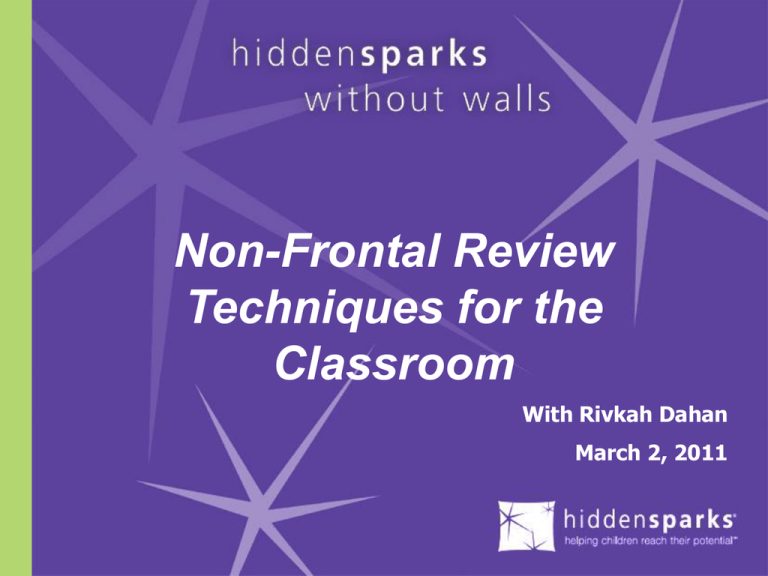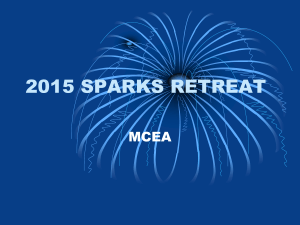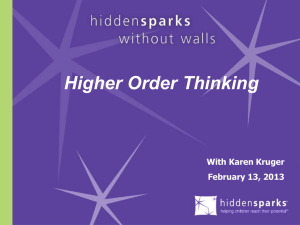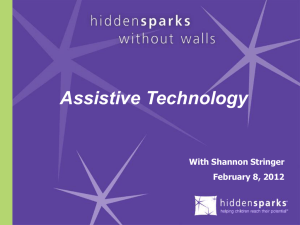Object of Game - Hidden Sparks
advertisement

Non-Frontal Review Techniques for the Classroom With Rivkah Dahan March 2, 2011 Our Guest: Mrs. Rivkah Dahan is the newly appointed Director of Education for Hidden Sparks. A former mainstream and special education teacher, She holds a Master’s Degree in Special Education from City University of New York, is a certified advanced trainer for the Nurtured Heart approach, and has served as a mentor for The Jewish New Teacher Project. She was the founding director of Torah Umesorah’s Brooklyn Educational Resource Center serving teachers and principals nation-wide, as well as Director at the Teacher Center of the Jewish Education Center of Cleveland. She is the co-author of Creating a Learning Environment: The Ultimate Jewish Teacher’s Handbook and is a nationally recognized presenter. © 2011 Hidden Sparks Session Goals: • Review the role of memory in learning • Understand how games can help teachers reinforce lessons and help students with long term memory storage and retrieval of information • Develop a tool chest of review games and techniques to enable students to enjoy learning © 2011 Hidden Sparks Overview of the Session • Components of memory and their role in reviewing classroom material • The benefits of using review activities • Solutions to some common challenges of using review activities in the classroom • Practical Goals for Activities • Simple non-frontal review techniques & strategies to help students improve their memory skills. © 2011 Hidden Sparks What is Memory? “STORAGE” LONGTERM MEMORY STORAGE LONGTERM MEMORY RETRIEVAL Retrieving facts, skills, and experiences after an extended delay •Recalling chunks of knowledge on demand •Recognizing information that you’ve encountered before © 2011 Hidden Sparks “RETRIEVAL” Storing information for recall at a later time •Filing information: store it, name it, & be able to get it out when needed. Long Term Memory Consolidation… …Storing information for recall at a later time A student who struggles with long term memory storage might… …Struggle to remember daily routines in school …Have difficulty remembering the sounds and names of letters …Have difficulty learning new terminology, facts, and procedures i.e. Steps in long division …Have particular trouble with cumulative subjects …Struggle to recall information even when given recognition cues (like multiple choice options) © 2011 Hidden Sparks Long Term Memory Access… …Recalling information after an extended delay, including facts, skills, and experiences …Recognizing material, such as multiple choice option or remembering a face A student who struggles with long term memory retrieval might… …Have difficulty retrieving one half of a pair when given the other half (such as definitions with terms and names with faces) …Be slow to recall facts …Use incorrect procedure for a problem or situation © 2011 Hidden Sparks Why Use Games to Review? How review games benefit you and your students: Games… foster cooperation among students individualize the learning process develop and reinforce learning skills in an interesting manner are intrinsically motivating get students to actively participate in the learning process free teachers to work with small groups or with individual students who require special help and encouragement individual games enable students to work at their own pace allow for movement and activity © 2011 Hidden Sparks Long Term Memory Strategies • Use physical movement, activities, role-play and hands-on learning to add a sensory element to cognitive activity. • Review previous lessons/relevant material to trigger information in students’ long term memory. • Conduct oral and written reviews daily and weekly, to build & associate learned concepts. • Play review games that help memory – i.e. Concentration (using numbers, words, symbols), • Play word games i.e. “Scrabble,” “Password,” and Jeopardy” to increase speed of retrieval. • Create organizational activities for vocabulary words (organized by prefixes and suffixes), chemical equations (organized by type of reaction), math problems (organized by problem solving method), etc. at varying levels of difficulty. © 2011 Hidden Sparks Long Term Memory Strategies • Have students: • Create flashcards, study guides, & test questions. • SAFMEDS – Say All Fast Minute Every Day Shuffled • Work in teams, drilling each other on facts using review activities. • Write and submit questions they think will be on the test and use them as the basis for a review game. • Self-test information by using self-checking review activities. • Point out the importance of organizational structures for learning/understanding and studying/remembering. • Organize words and concepts in categories in a game format. © 2011 Hidden Sparks What are Some Challenges of Using Classroom Review Games? • “I don’t have time” • “I’m not creative” • “What about the student that can’t follow directions? • What about students who don’t remember the information?” • “I’m concerned about students becoming unruly” • “I have 35 students – how can I play games?” © 2011 Hidden Sparks …games taking too much time away from learning …creating games with measurable goals that meet your learning objective. …playing games with large classes and students getting unruly when they have to wait their turn for too long …playing games in pairs or small groups. …not knowing how to use games to assess student learning. …making games self-checking. Have students record their answers. …students getting frustrated with the rules or games requiring too much teacher intervention. …games creating unhealthy competition among students. Then Think About... If you're concerned about... Overcoming Stumbling Blocks …test-driving the game before giving to students. Providing clear oral & written instructions. Making sure games are age appropriate – challenging but not too complex. …making game rules fair & allowing ample opportunities for all students to succeed. …games being heavy to schlep and too large to store. …creating games out of paper or store games in a movable bin that can be stored outside the classroom. …not being creative enough. …listening to the rest of this webinar! © 2011 Hidden Sparks Types of Games Card Games Board Games Running/Moving Games Other Uno Candy land Hopscotch Connect the Dots Headbandz Chutes and Ladders Fruit Basket Go Fish Sorry Twister Memory/Concentration Trouble Relay Races War Trivial Pursuit Across the Sea Old Maid Checkers Baseball Skip Bo Payday Basketball Bingo Charades Connect Four Duck-Duck-Goose Tic-Tac-Toe Bean Bag Toss Bananagrams Bowling © 2011 Hidden Sparks Skills skill \’skil\ : proficiency, facility, or dexterity that is acquired or developed through training or experience שמש Recalling Facts Identifying Matching Sorting/ Classifying/ Grouping Automaticity w/Sequencing © 2011 Hidden Sparks Comparing/ Contrasting General Studies Activity Ideas - Samples Identifying Matching Sorting Grouping Classifying Sequencing Recalling Facts Comparing Contrasting Locate parts of the body on a picture Match the word to the picture that has the initial sound Sort objects by color/shape Sequence the stages of tree growth Count from 110, sing the ABC's B's and D's & other commonly confused letters Identify parts of a cell Match the word to its definition. Classify animals by habitat Sequence the lifecycle of a butterfly List the 7 continents Compare and contrast the properties of a rectangle and a square. Identify the problems and solutions in a current or historical event. Match part of cell to its function Sort food pictures by proteins & carbohydrates Sequence the US Presidents List the character traits of one of the personalities studied Compare life in Jamestown during the 1600’s to life in Jamestown during the 1900’s. © 2011 Hidden Sparks Judaic Studies Activity Ideas - Samples Identifying Matching Sorting Grouping Classifying Sequencing Recalling Facts Comparing Contrasting Identify sound that object begins with Match the food to its bracha Sort symbols by yom tov Sequence the alef-bet letters List the things plants need to grow What's the same and what's different: Rachtza /Urchatz Identify in Match picture to Hebrew what pasuk/phrase it one wears in represents different types of weather Sort pesukim by who said them Sequence this week's ketiva words alphabetically List the Parshiot in order Hebrew Reading: Same sound/different sound Identify which shevet each bracha in birchot yaakov was given to. Sort mitzvot by Sequence the those relevant in events in the Israel and megillah/parsha outside of Israel List the things that are forbidden to a nazir Compare and contrast the 10 dibrot in Parashat Yisro and Va’eschanan. © 2011 Hidden Sparks Match the 39 melachot w/av melacha or toldah Game Idea #1 – Egg Carton/Muffin Tin Toss Players: 1-2 players. Materials needed: Empty egg carton or muffin tin, 1 coin, 2 manipulatives, pen/marker Setup: Write numbers in the bottom of egg carton. Put two manipulatives in the egg carton. Gameplay: • The student closes the lid, shakes the egg carton, opens the lid and notices where the manipulatives landed. • The student multiplies the 2 #’s together & solves the problem. • Students take turns playing for 5 minutes scoring 1 point for each equation solved. © 2011 Hidden Sparks Game Idea #2 – Memory/Concentration Players: 1 to 6 players. Deck: Up to 52-card deck. Object of Game: To collect the most pairs of cards. Setup: Shuffle the cards and lay them on the table (or for larger cards lay on floor), face down, in a pattern (e.g. 4 cards x 13 cards). Gameplay: • Youngest player goes first. Play proceeds clockwise. • On each turn, a player turns over two cards (one at a time) and keeps them if they match. If player successfully matches a pair, that player gets to take another turn. • When a player turns over two cards that do not match, those cards are turned face down again and it becomes the next player’s turn. © 2011 Hidden Sparks Game Idea #3 - Graffiti Review Players: Individual students or groups of 2-3 students Materials needed: Chart pack paper & markers Object of game: Write everything you know about a topic in a limited amount of time. Setup: Spread out or post chart paper at stations around the room (wall, desks, floor). Each piece of chart paper is given a title/topic. Gameplay: • Each group starts at a different piece of chart paper • Students write everything they know about topic at that station. • After 30 second or 1 minute interval – students rotate to next station • After students have gone through all topics, gather papers • Read results as a class • Correct and complete information on pages © 2011 Hidden Sparks Game Idea #4 – First Things First Players: 2 Deck: 8 cards Materials needed: 3x5” index cards, answer key Object of game: Be the first team to discard the 2 cards containing events that are not relevant to the topic and then arrange the remaining cards in chronological order. To Prepare Cards: Create for each pair of students 1 set of 6 cards containing events that occurred during a particular historical time period and 2 cards that contain random historical events. Gameplay: • On the “go” signal, each pair places cards face up on table/floor in front of them. Students remove non-relevant cards & putt remaining cards in chronological order. • Once all cards are sequenced, students use the answer key to check for accuracy. © 2011 Hidden Sparks Game Idea #5 – Simply Kosher Players: 2-4 players Object of Game: Sort items by category Materials needed: 2 shoeboxes (1 labeled “Kosher” the other labeled “Non-Kosher”), 2 bags containing plastic animals or flashcards with photographs of animals Gameplay: • Students take turns choosing items from their bags and placing them in the correct shoebox. © 2011 Hidden Sparks Game Idea #6 – Duck, Duck, Goose Players: 4 to 6 players or Whole class. Materials needed: Lists of categories Object of Game: Help students review Setup: Students sit on the floor/chairs in circle facing inward. 1 student in each group is “it”. Gameplay: • Kids sit in a circle facing each other. • One person is "it" and walks around the circle tapping people's heads and saying whether they are a "duck" or a "goose". • The "goose" gets up and chases "it" around the circle. • The goal is to tap that person before they are able sit down in the "goose's" spot. • If the goose is not able to do this, they become "it" for the next round and play continues. • If they do tap the "it" person, the person tagged has to sit in the center of the circle. Then the goose become “it” for the next round. The person in the middle can't leave until another person is tagged and they are replaced. © 2011 Hidden Sparks Game Idea #7 – Human Board Game Players: 2-6 players Deck: 12-24 cards Materials needed: construction paper/card stock, marker, cube-shaped box covered contact paper. Glue black circles or numbers to box to resemble a large die Cards: Create the game board using posterboard or construction paper size numbers for the students to stand on. This is the game board. Prerequisite: Knowledge of multiplication/addition facts. Object of game: Be the first player to reach the end of the “board”/ Review multiplication/addition facts Setup: Lay cards face up on floor in front of each team . Gameplay: • Players line up in front of “board”. • Players take turns rolling the die, and walking # of spaces on die. • Players must complete the math equation (either multiply, add, or subtract) created by the number they stand on and the number they rolled on the dice. i.e. 5 (number spun on die) multiplied by 8 (8 is on the square). If player lands on occupied space, player on space moves back 3 spaces. • Incorrect answers move back one space. (Rules can be added or deleted depending on your class) • Winner is the first player to reach the end of the game board. © 2011 Hidden Sparks Sample Activity Ideas – Judaic Studies Do this on your own: •Choose a subject. •Think of one activity for each skill that you can incorporate into a game for your class. RECALLING FACTS SORTING Learning Objective: Learning Objective: Learning Objective: Students will match Students will sort Students will list a picture of a creation to pictures of objects onto what G-d created on the # of the day on which the day they were created. each day. it was created. IDENTIFYING SEQUENCING COMPARING Learning Objective: Learning Objective: Students will compare Students will identify Students will sequence What was created pictures in the order in first day to what G-d said on Day #6. which they were created. after the 3rd day. Learning Objective: © 2011 Hidden Sparks MATCHING what G-d said after the Additional Game Resources • www.Chinuch.org Chinuch.org is a website on which Jewish educators can share curricula, instructional ideas and best practices. The site also has a forum that provides an opportunity for teachers of students with special needs to discuss current issues in the field, get advice from other professionals and network with other teachers and parents in similar situations to theirs. • Dr. Sivasailam Thiagarajan (Thiagi, for short) is a well known expert in the area of learning games. http://www.thiagi.com/games.html provides 100’s of free games and activities that engage participants & keep them interacting with each other and with the content. • SAFMEDS Instructions can be found at Indiana Designs Equitable Access for Learning’s website www.idealindiana.com/mods.asp?id=85&sectionID=138 © 2011 Hidden Sparks Some Final Thoughts – Activity Ideas for YOUR Class Think of one game/activity that you can play with your class tomorrow that will reinforce one skill. © 2011 Hidden Sparks Upcoming Hidden Sparks Without Walls Sessions Tuesday, May 17, 2011 Assessment and Differentiated Instruction, with Dr. Jane Gertler For more information visit: www.hiddensparks.org © 2011 Hidden Sparks Contacting Hidden Sparks Contact Rivkah Dahan: RIVKAH@HIDDENSPARKS.ORG Contact Hidden Sparks: www.hiddensparks.org margaret@hiddensparks.org (212) 767-7707 © 2011 Hidden Sparks About Hidden Sparks Hidden Sparks is a non-profit fund whose purpose is to help children with learning differences reach their full potential in school and life. Hidden Sparks develops and supports professional development programs for Jewish day schools to help increase understanding and support for teaching to diverse learners. Guided by a philosophy that by helping schools meet the needs of children with learning and behavioral differences, ultimately all students will benefit. Hidden Sparks’ programs combine professional development in learning and positive behavioral support, guided classroom observation and one on one coaching. The Hidden Sparks model and program is currently in 21 Jewish Day Schools/Yeshivot in New York and 7 in Boston, through a partnership with Gateways: Access to Jewish Education. © 2011 Hidden Sparks Comic Relief - Memory © 2011 Hidden Sparks Brainstorming Get those gaming juices flowing! How many games can you think of in each of these categories? Card Games © 2011 Hidden Sparks Board Games Running/Moving Games Other Classroom Games Cheat Sheet Preparation for games is imperative to their success. A teacher should be thoroughly familiar with a game before presenting it to a group. In conducting games, remember the following key words: ORGANIZE STATE the players before the game begins. how the game is played. ASK PLAY if there are any questions. ...instructions with a minimum of interruptions STOP the game when the students are still having fun. © 2011 Hidden Sparks Motivation is the key to success, and the teacher/facilitator is the key to motivation. S/he must always present the games enthusiastically and intelligently. Sample Activity Ideas Planning Sheet Do this on your own: •Choose a subject. •Think of one activity for each skill that you can incorporate into a game for your class. © 2011 Hidden Sparks SORTING RECALLING FACTS MATCHING Learning Objective: Learning Objective: Learning Objective: Students will sort Students will recall Students will match IDENTIFYING SEQUENCING COMPARING Learning Objective: Learning Objective: Learning Objective: Students will identify Students will sequence Students will compare What is Memory? Mentally juggling information while using it in some way Briefly registering new information •Actively using the information •Memory for keeping things together in your mind while it is being used. •Being able to hold different pieces of information and use them at the same time. •Can be seconds, minutes, or hours •The process of taking information coming in and filing it in long term is active working memory. •Only lasts for seconds •A very small space to hold information •You need to decide quickly “save or delete” “STORAGE” Retrieving facts, skills, and experiences after an extended delay •Recalling chunks of knowledge on demand •Recognizing information that you’ve encountered before © 2011 Hidden Sparks “RETRIEVAL” Storing information for recall at a later time •Filing information: store it, name it, (& be able to get it out when needed). Game Idea #1 – Egg Carton/Muffin Tin Toss Players: 1-2 players. Materials needed: Empty egg carton or muffin tin, 1 coin, 2 manipulatives, pen/marker Setup: Write numbers in the bottom of egg carton. Put two manipulatives in the egg carton. Gameplay: • The student closes the lid, shakes the egg carton, opens the lid and notices where the manipulatives landed. • The student multiplies the 2 #’s together & solves the problem. • Students take turns playing for 5 minutes scoring 1 point for each equation solved. Variation: 1. 2. Write vocabulary words in egg carton/muffin tin. Player 1 tosses coin into egg carton/muffin tin & observes where coin has landed. Conjugate the 2 words listed. Give yourself a point for every correct answer. Play continues with players taking turns tossing coins and conjugating words. Judaic Studies Variations: Early Childhood: alef bet, Lower Elementary: holiday dates, biblical dates, months of year, identify rashi letters, beurei milim Upper Elementary: © 2011 Hidden Sparks General Studies Variations: Early Childhood: numbers, colors, abc, shapes, symbols Lower Elementary : math facts, contractions, Upper Elementary: history dates, vocabulary words, science terms Game Idea #2 – Memory/Concentration Players: 1 to 6 players. Deck: Up to 52-card deck. Object of Game: To collect the most pairs of cards. Setup: Shuffle the cards and lay them on the table (or for larger cards lay on floor), face down, in a pattern (e.g. 4 cards x 13 cards). Gameplay: • Youngest player goes first. Play proceeds clockwise. • On each turn, a player turns over two cards (one at a time) and keeps them if they match. If player successfully matches a pair, that player gets to take another turn. • When a player turns over two cards that do not match, those cards are turned face down again and it becomes the next player’s turn. Judaic Studies Ideas: Early Childhood: pictures/words, alef bet letters Lower Elementary: chumash words/translations, prefix-suffix/definitions, holidays/dates, print/script, yachid/rabim, beginning of tefilla/end of tefilla Upper Elementary: words/definitions, word/shoresh, General Studies Variations: Early Childhood: upper case to lowercase letters, picture to initial consonant, numbers, patterns, shapes Lower Elementary: states/capitals, print/script, math facts, questions/answers © 2011 Hidden Sparks Upper Elementary: explorer/discovery, historical event/date, body system/organs Game Idea #3 - Graffiti Review Players: Individual students or groups of 2-3 students Materials needed: Chart pack paper & markers Object of game: Write everything you know about a topic in a limited amount of time. Setup: Spread out or post chart paper at stations around the room (wall, desks, floor). Each piece of chart paper is given a title/topic. Gameplay: • Each group starts at a different piece of chart paper • Students write everything they know about topic at that station. • After 30 second or 1 minute interval – students rotate to next station • After students have gone through all topics, gather papers • Read results as a class • Correct and complete information on pages © 2011 Hidden Sparks Game Idea #4 – First Things First Players: 2 Deck: 8 cards Materials needed: 3x5” index cards, answer key Object of game: Be the first team to discard the 2 cards containing events that are not relevant to the topic and then arrange the remaining cards in chronological order. To Prepare Cards: Create for each pair of students 1 set of 6 cards containing events that occurred during a particular historical time period and 2 cards that contain random historical events. Gameplay: •On the “go” signal, each pair places cards face up on table/floor in front of them. Students remove non-relevant cards & putt remaining cards in chronological order. •Once all cards are sequenced, students use the answer key to check for accuracy. Judaic Studies Variations: Early Childhood: alef bet, 10 makkot, order of passover seder, Lower Elementary: parshiot in each sefer, parts of tefilla, 12 shevatim, months of the year Upper Elementary: Kings of Yisrael, Kings of Yehuda, 39 melachot, timeline of Jewish History © 2011 Hidden Sparks General Studies Variations: Early Childhood: Abc’s, daily schedule, seasons, days of week, months of year, Human Alphabet Lower Elementary: lifecycle of a butterfly, US presidents Upper Elementary: government chain of command, food chain, states that joined the union Game Idea #5 – Simply Kosher Players: 2-4 players Object of Game: Sort items by category Materials needed: 2 shoeboxes (1 labeled “Kosher” the other labeled “NonKosher”), 2 bags containing plastic animals or flashcards with photographs of animals Gameplay: • Students take turns choosing items from their bags and placing them in the correct shoebox. Judaic Studies Variations: Early Childhood: holidays, colors, shapes, letters, seasons, Lower Elementary: fathers/sons, families, Hebrew grammar rules, brachot, הווה-אמהות עבר- שבטים,עשו- יעקב,נקבה-זכר, Upper Elementary: 10 commandments listed parshat yitro & v’etchanan © 2011 Hidden Sparks General Studies Variations: Early Childhood: colors, shapes, numbers, texture, pictures, seasons, clothing, fruits/vegetables, magnetic/non-magnetic Lower Elementary : mammals/amphibians, customs/country Upper Elementary: geographic regions, climate, pros & cons of being in North/South during Civil War, monarchy/democracy Game Idea #6 – Duck, Duck, Goose Players: 4 to 6 players or Whole class. Materials needed: Lists of categories Object of Game: Help students review Setup: Students sit on the floor/chairs in circle facing inward. 1 student in each group is “it”. Gameplay: • Kids sit in a circle facing each other. • One person is "it" and walks around the circle tapping people's heads and saying whether they are a "duck" or a "goose". • • The "goose" gets up and chases "it" around the circle. • The goal is to tap that person before they are able sit down in the "goose's" spot. • If the goose is not able to do this, they become "it" for the next round and play continues. • If they do tap the "it" person, the person tagged has to sit in the center of the circle. Then the goose become “it” for the next round. The person in the middle can't leave until another person is tagged and they are replaced. © 2011 Hidden Sparks Variations: Rhyming words (cat, bat, mat, CAKE), Yom Tov articles (shofar, machzor, honey, SUKKAH), dikduk words (rotzah, rotzah, rotzah, rotzeh), Initial consonant words (bat, ball, bill, CAT)







